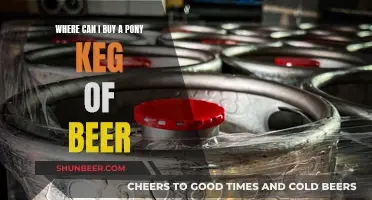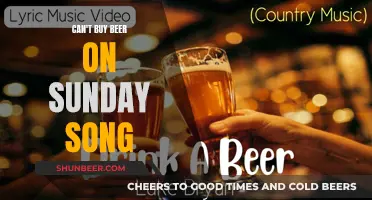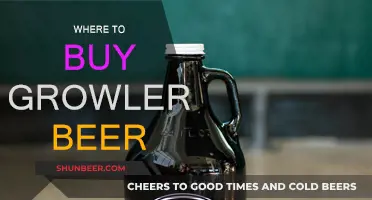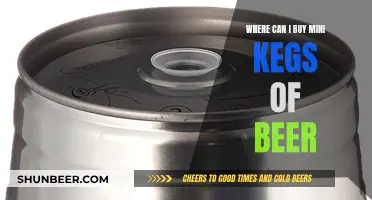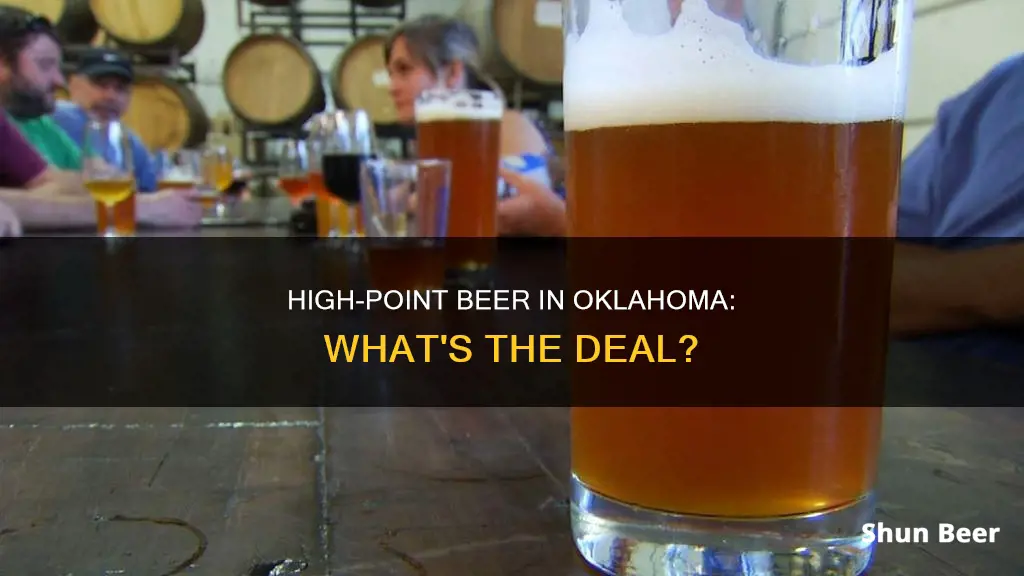
Oklahoma's alcohol laws have been subject to much debate and have undergone several changes in recent years. The state's unique measurement of alcohol by weight (ABW) rather than the more common volume (ABV) has been a source of confusion, with some claiming that Oklahoma's beer has a significantly lower alcohol content. In reality, the difference is negligible, and the change from 3.2% ABW to 4.0% ABV only amounts to a small increase in alcohol content.
In the past, Oklahoma was one of the few states that only offered low-point beer under refrigeration, but this changed in October when new laws were implemented. Now, high-point beer can be purchased in convenience and grocery stores, and liquor stores are allowed to sell refrigerated beer. These changes have provided Oklahomans with greater access to a wider range of alcoholic beverages and have brought the state's laws more in line with those of its neighbours.
| Characteristics | Values |
|---|---|
| Alcohol content | 3.2% ABW or 4% ABV |
| Availability | Convenience stores, grocery stores, and liquor stores |
| Temperature | Refrigerated |
| Purchase limitations | None |
What You'll Learn

Oklahoma's high-point beer legislation
Oklahomans have had a tumultuous relationship with alcohol, with the state constitution including the prohibition of alcohol when Oklahoma became a state in 1907. In 1933, when the Federal government repealed the 18th Amendment, Oklahoma did not ratify the new 21st Amendment. Instead, it approved the sale of beer containing not more than 3.2% alcohol by weight with the Oklahoma Beer Act of 1933.
In 1959, the legislature voted on House Bill 825, which repealed prohibition and created the Alcohol Control Board, now known as the ABLE commission (Alcohol Beverage Laws Enforcement). Alcohol stronger than 3.2% by weight could only be sold by a licensed retail package store at room temperature. Any establishment with a beer license could sell 3.2% by weight beer, regulated by Oklahoma's ABLE commission.
In 1976, Oklahoma's distribution laws, commonly known as reverse franchising or the open wholesale system, prompted a local distributor to sue a major domestic brewer for turning down an order. The brewing company explained that they already had a distributor in the same territory. An Oklahoma Supreme Court judge issued an opinion ruling that the brewing company violated Oklahoma's distribution laws, which prohibited franchising among distributors. In response, most major domestic brewers discontinued selling strong beer in Oklahoma in the late 1970s, opting to sell only 3.2% by weight beer as it was not regulated by ABLE.
This moratorium continued until the early 2010s when some of the major domestic brewing companies returned a few of their products to liquor store shelves due to strong demand by Oklahoma consumers. In 2012, a group known as Oklahomans for Modern Laws filed an initiative petition seeking a statewide vote on a proposal for wine to be sold in grocery stores in 15 Oklahoma counties with populations of more than 50,000. The petition was eventually withdrawn and has not been resubmitted.
In 2016, Oklahoma passed State Question 792, which was the most comprehensive reform of Oklahoma's alcoholic beverage laws. The reform allowed grocery stores, convenience stores, pharmacies, and other establishments to sell strong beer and wine. It also allowed liquor stores to sell cold beverages and non-alcoholic items and implemented a territorial franchise wholesale system, which encouraged major domestic brewers and other craft brewers to begin selling in Oklahoma for the first time in decades.
In 2021, House Bill 2122, also known as the Cocktails-to-Go Act, went into effect. The legislation allows establishments with Mixed Beverage Licenses to sell "cocktail, mixed drink, or single-served wine" in a "sealed container" for off-premises consumption.
Oklahoma's policy for regulating the sale of alcohol has evolved over time, with the state transitioning from prohibition to allowing the sale of low-point beer, and eventually passing comprehensive reforms to permit the sale of higher-point beer and wine in various establishments.
Beer Buying at RDU: What's Allowed?
You may want to see also

The difference between ABW and ABV
As of October 2024, Oklahoma has changed its alcohol laws, allowing high-point beer to be sold in convenience and grocery stores. Previously, only low-point beer (3.2% alcohol by weight) could be sold in these stores, and only high-point beer (above 3.2% ABW) could be sold in liquor stores. Now, high-point beer can be sold in liquor stores and kept refrigerated, but it must still be purchased from these stores.
Alcohol by volume (ABV) and alcohol by weight (ABW) are two different ways to measure the alcohol content of a beverage. ABV is the standard measure, used worldwide, and is defined as the number of millilitres (mL) of pure ethanol present in 100 mL of solution at 20°C. ABW, on the other hand, measures the proportion of a drink's mass which is alcohol.
ABV is calculated using the following formula:
> ABV = (number of mL of pure ethanol) / (volume of solution) x 100
ABW can be calculated as:
> ABW = (mass of alcohol) / (total mass of solution) x 100
For example, if a 330 mL solution contains 10 g of ethanol, the ABV would be:
> ABV = (10 / 330) x 100 = 3.03%
And the ABW would be:
> ABW = (10 / 340) x 100 = 2.94%
As you can see, the ABV and ABW values are different for the same solution. This is because alcohol is less dense than water, so the volume of alcohol in a solution will be greater than the weight of alcohol in the same solution.
When comparing the alcohol content of different beverages, it is important to make sure that you are comparing the same type of measurement (ABV or ABW). In the US, Arkansas, Kansas, Mississippi, South Carolina, and Tennessee regulate and tax alcoholic beverages according to ABW. However, ABV is more commonly used and is the standard measure listed on beverage labels.
ABW can be converted to ABV by multiplying it by the density of alcohol (0.795). So, a 3.2% ABW beer is approximately 4.0% ABV. Conversely, ABV can be converted to ABW by dividing it by the density of alcohol.
It is worth noting that the difference between ABV and ABW becomes more significant as the alcohol content increases. For example, a 10% ABV beer would be approximately 12.5% ABW, while a 20% ABV liquor could be as high as 25% ABW.
Where to Buy Deschutes Mirror Pond Beer in Wyoming
You may want to see also

Oklahoma's alcohol laws
In 2016, Oklahoma passed State Question 792, which was a comprehensive reform of the state's alcohol laws. This allowed grocery stores, convenience stores, and pharmacies to sell strong beer and wine. It also meant that liquor stores could sell cold beverages and non-alcoholic items.
Prior to these changes, Oklahoma was one of only five states that offered only low-point beer under refrigeration. High-point beer, with an alcohol content of over 3.2%, could only be sold at room temperature in state-regulated liquor stores.
The new laws also implemented a territorial franchise wholesale system, which encouraged major domestic brewers and craft brewers to sell in Oklahoma for the first time in decades. Now, any establishment with a beer and wine license can sell beer and wine up to 15% ABV under refrigeration.
The legal drinking age in Oklahoma is 21, and it is a felony to provide alcohol to those under this age, as well as the mentally deficient and the intoxicated. Minors are also prohibited from possessing or purchasing alcohol, although consumption in a "private setting" is not prohibited.
Oklahoma has strict rules regarding the sale and distribution of alcohol. Liquor stores can sell spirits or wine but not cold beer, while grocery and convenience stores can only sell beer. All establishments serving alcohol must have a valid license and must adhere to rules regarding hours of operation.
Oklahoma has seen a reduction in alcohol-impaired driving fatalities, with rates decreasing by 48.5% for under-21s and 33% for the general population from 2010-2019. However, the state ranks 6th in alcohol-related mortality, and alcohol plays a role in many personal injuries and crimes.
Overall, while Oklahoma's alcohol laws have become more relaxed in recent years, the state still has strict regulations regarding the sale, distribution, and consumption of alcohol.
Buying Beer in Idaho: Sunday Shopping Laws Explained
You may want to see also

The history of alcohol laws in Oklahoma
In 1933, Oklahoma approved the sale of beer containing no more than 3.2% alcohol by weight with the Oklahoma Beer Act. However, this beer could only be sold at room temperature and not refrigerated. This led to a unique situation where beers like Budweiser, Miller, and Coors had to brew their beers to exactly 3.2% alcohol by weight for the Oklahoma market, resulting in a negligible difference in alcohol content compared to beers sold in other states.
It wasn't until 1959 that Oklahoma citizens voted to end the prohibition against selling wholesale and retail packaged alcoholic beverages. The Liquor Control Act of 1959 set up the Alcoholic Beverage Laws Enforcement Commission (ABLE Commission) to regulate liquor sales and stores. This commission issued licenses and enforced regulations, allowing liquor stores to legally operate for the first time since 1907.
In 1976, Oklahoma's distribution laws, known as reverse franchising or the open wholesale system, led to a lawsuit when a local distributor sued a major domestic brewer for turning down an order. An Oklahoma Supreme Court judge ruled that the brewer violated the state's distribution laws, prompting most major domestic brewers to discontinue selling strong beer in the state. This moratorium continued until the early 2010s when some companies returned a few of their products to liquor store shelves due to consumer demand.
In 1984, Oklahoma became the 49th state to allow liquor by the drink with the passage of State Question 563. This meant that establishments with a liquor license could sell alcoholic beverages for consumption on-premises.
The most significant reform of Oklahoma's alcoholic beverage laws came in 2016 with the passing of State Question 792. This reform allowed grocery stores, convenience stores, and pharmacies to sell strong beer and wine, and liquor stores to sell cold beverages. It also implemented a territorial franchise wholesale system, encouraging major domestic brewers and craft brewers to sell their products in the state for the first time in decades.
Today, Oklahoma has a comprehensive set of alcohol laws that regulate the sale, consumption, and distribution of alcoholic beverages. The minimum age to purchase alcohol is 21, and there are strict penalties for providing alcohol to minors or intoxicated individuals. Oklahoma has also outlawed public intoxication and driving under the influence, with harsh penalties for those who violate these laws.
Jam Doughnut Beer: Where to Buy This Sweet Treat?
You may want to see also

The future of alcohol laws in Oklahoma
Oklahoma's alcohol laws have been through a series of changes in the past decade, with the most comprehensive reform passed in the 2016 November general elections. The reform allowed grocery stores, convenience stores, and pharmacies to sell strong beer and wine, and permitted liquor stores to sell cold beverages.
The state's alcohol policy was created when Prohibition was repealed in 1959. Until 2016, Oklahoma was one of only five states that offered only low-point beer under refrigeration, and three of those states are considering doing away with the requirement.
The 2016 reform implemented a territorial franchise wholesale system, which encouraged major domestic brewers and craft brewers to sell in Oklahoma for the first time in decades. Oklahoma now allows any establishment with a beer and wine license to sell beer and wine up to 15% ABV, under refrigeration.
There is also a desire for more variety, with residents frustrated by the lack of craft beer options and the fact that many brewers won't distribute in Oklahoma due to the restrictions on sales in grocery stores and gas stations. The unique way Oklahoma measures alcohol by weight, rather than volume, has also caused confusion and frustration.
However, there is some resistance to changing the state's alcohol regulations. Opponents express concern about underage drinking and the potential impact on society, with alcohol characterised as a "dangerous product" that can lead to various physical and social issues.
The balance between modernising alcohol laws and addressing public health and safety concerns will likely continue to shape the future of alcohol legislation in Oklahoma.
Lone Star Beer: Where to Buy in Georgia?
You may want to see also
Frequently asked questions
Yes, liquor stores are permitted to operate between 8:00 a.m. and midnight on Sundays in counties where it is allowed.
Yes, grocery stores are allowed to sell beer and wine from 6 a.m. to 2 a.m., Sunday through Saturday.
Yes, convenience stores are allowed to sell beer and wine from 6 a.m. to 2 a.m., Sunday through Saturday.



